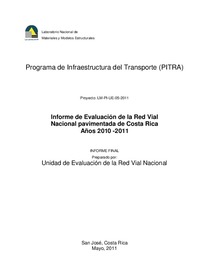Informe de evalución de la red vialnacional pavimentada de Costa Rica años 2010-2011
Date
2011-03Author
Barrantes Jiménez, Roy
Loría Salazar, Luis Guillermo
Metadata
Show full item recordAbstract
Bajo el marco de Ley 8114, les corresponde a LANAMMEUCR realizar una evaluación cada dos años del estado de la Red Vial Nacional pavimentada, la cual sirve como instrumento eficaz e imparcial de rendición de cuentas y de planificación técnica par la gestión vial y de la inversión publica realizada.
Los parámetros técnicos con los que se realizo la evaluación de la red de carreteras en los años 2010-2011 están relacionado s directamente con la vida útil o de servicio con el costo de operación de la flota vehicular que circula y con la seguridad vial al evaluar la fricción de la superficie para facilitar el frenado de los vehículos. Se utilizo el deflectómetro de impacto (FWD), para medir las deflexiones superficiales obtenidas al someter al pavimento a una fuerza qu simula cargas de transito, lo que permite inferir la capacidad soportante de dicho pavimento y con ello, la vida útil remanente en dicha estructura. Por otra parte se utilizó el perfilómetro laser, el cual mide la Irregularidades Superficiales (IRI) de las vías, que se asocia tanto con el confort que siente el usuario que circula dicho tramo, como principalmente con los costos de operación de los vehículos que usan las carreteras. En el tema de seguridad vial, el equipo de fricción o agarre (GRIP) permitió medir el coeficiente de rozamiento existente entre pavimento y las llantas, lo que determina su adherencia a la calzada y que se relaciona directamente con el índice de peligrosidad e una ruta. Adicionalmente, se realizo la evaluación de estado de demarcación con pintura, que es de suma importancia para la guía segura de la flota vehicular que usa las vías tanto de día como de noche. Under the framework of Law 8114, it is up to LANAMMEUCR to conduct an evaluation every two years of the state of the paved National Road Network, which serves as an effective and impartial instrument of accountability and technical planning for road and investment management published realized.
The technical parameters with which the assessment of the road network was carried out in the years 2010-2011 are directly related to the service life or service cost of the vehicle fleet that circulates and to road safety when evaluating the friction of the surface to facilitate the braking of the vehicles. The impact deflectometer (FWD) was used to measure the surface deflections obtained by subjecting the pavement to a force that simulates traffic loads, which allows inferring the bearing capacity of said pavement and with it, the remaining useful life in said structure . On the other hand, the laser profilometer was used, which measures the Surface Irregularities (IRI) of the roads, which is associated both with the comfort felt by the user traveling this section, and mainly with the operating costs of the vehicles they use. the roads. In terms of road safety, the friction or grip (GRIP) equipment allowed to measure the coefficient of friction between pavement and tires, which determines its adherence to the roadway and which is directly related to the hazard index in a route . Additionally, the evaluation of the state of demarcation with paint was carried out, which is of utmost importance for the safe guidance of the vehicular fleet that uses the roads both day and night.
Collections
- Informes [1102]

